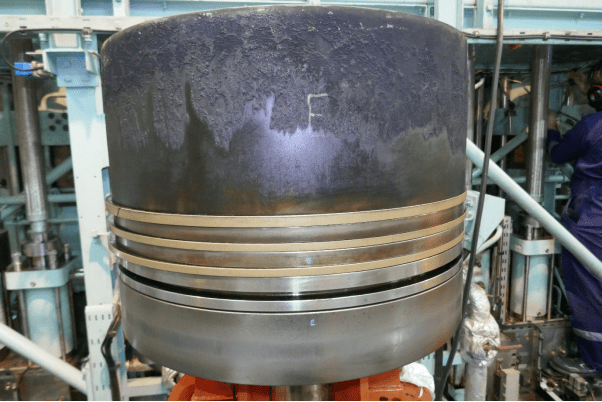New low-BN oil delivers cleanliness for low-sulphur fuel operations
When the IMO’s fuel sulphur limit came into effect on 1 January 2020, the resulting use of low sulphur fuel created a challenge to lubrication. The familiar balance between acidic high-sulphur fuels and high base-number (BN) alkaline lube oils had to be replaced by somehow maintaining cleanliness in the engine with a less alkaline, lower-BN, lube oil.
Engine designer MAN Energy Solutions (MAN ES) alerted the industry to the potential impact of low-sulphur fuels in an April 2019 service letter, /JAP, nearly nine months before the sulphur cap came into effect.
A year later, in May 2020, MAN ES issued another service letter, /JUSV, which set out a new cylinder oil strategy “where the objective is to raise the performance level of cylinder oils by dividing them into two performance categories”, termed Category I and Category II.
For its Mk 9 engines and above, the higher performance Category II oils were recommended. Initially only 100 BN and 140 BN oils met the requirements; but the intention was that other lubricant grades, such as the 40 BN oil would, follow.
Chevron Marine Lubricants has now met MAN ES’s requirements with its 40 BN Taro Ultra Advanced 40 lube oil, which has passed the two-stage main NOL (No Objection Letter) Service and Confirmation field tests required by MAN ES. These confirm its status as a Category II oil, enabling lower sulphur fuel engine operations with a low-BN oil.
Previously, MAN ES recommended that for their Mk 9 and newer engines, operators should alternate between 100 BN and 40 BN oils, while monitoring the engine by making scavenge port inspections and analysing oil drainage samples.
Taro Ultra Advanced 40 is one of the first oils in this product profile. It complements Chevron Marine Lubricants’ Taro Ultra 100 and Taro Ultra 140 higher BN products, which are already rated as Category II oils. It is designed for use with a range of low and zero sulphur fuels, including VLSFO, ULSFO, LNG and methanol and will become available across Chevron’s extensive global supply network in the second half of 2022.
The performance requirements included extensive field tests on vessels with MAN 8G80ME-C9.2 engines. Whereas earlier the ships had operated with 40 BN cylinder oil {MAN ES Category I} and VLSFO, alternating with 100 BN oil {MAN ES Category ii} to keep the engines clean, extended use with Taro Ultra Advanced 40 delivered a significant improvement. It was no longer necessary to alternate between two products to have excellent engine cylinder conditions. Furthermore, having a single product for all operational conditions reduces operational complexity for the crew.

‘Out-of-the-box’ thinking
Developing a low-BN lube oil with engine cleaning properties suitable for low-sulphur fuel required some ‘out-of-the-box’ thinking by Chevron. Unlike most new lubricants, where small steps are needed to progress from one formulation to another, because of the step-change in performance, Taro Ultra Advanced 40 required a different balance of components in the formulation process.
One critical ingredient in high-BN lubes is a calcium-based detergent. This keeps the engine clean and provides alkalinity (base number) to neutralize the sulfuric acid formed during combustion. However, it creates ash whichpasses from the combustion chamber into the exhaust and after-treatment systems, where it is not desirable, underlining the need for a suitable low-BN alternative. For low sulphur fuels, less sulphuric acid is formed, and less alkalinity is needed for neutralization ship operators might assume that since Category II status had been granted to existing high-BN oils, a lower-BN alternative would not be required. It becamenecessary to replace the performance of traditional high base numbers with something lower in ash, but still provides cleanliness and performance.
This product represents a new generation with a different way of formulating the oil’s chemistry. There was a definite development objective, and a clear mandate from MAN ES about what the oil should achieve. The selection of potential components and the formulation approach to meet the specification was based on Chevron’s technical expertise and the experience of its development team. The formulation was tested on a marine laboratory test engine prior to being submitted to MAN ES to verify the performance of Taro Ultra Advanced 40.
The testing protocol
Testing of Chevron Marine Lubricant’s Taro Ultra Advanced 40 was carried out in partnership with shipowner, Cape Shipping SA and MAN Energy Solutions. Cape Shipping operates a modern fleet with the type of engines targeted by the new oil.
MAN ES was closely involved in evaluating the candidate oil and the proposed test engine, pulling pistons at the start and finish of the tests to check parameters, such as deposits and wear. In collaboration with Chevron’s field test team, they monitored the engine, and conducted intermediate engine inspections and drain oil analyses, using Chevron Marine Lubricant’s DOT.FAST on-board test kit, which provides a quick analysis of unburned engine oil.
From the test data, MAN ES evaluated the oil’s performance based on several parametersto confirm that it is comparable or supersed es the 100 BN oil.
The Taro Ultra Advanced 40 lube oil will be recognised for its superior performance with its inclusion in the first list of 40 BN Category II oils to be published by MAN ES later this year.





